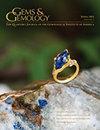多米尼加共和国蓝琥珀的荧光特性
IF 1.6
3区 地球科学
Q2 MINERALOGY
引用次数: 6
摘要
2020年冬季宝石与宝石琥珀广泛分布在世界各地。它不仅是一种见证地球历史并为古生物学家提供直接证据的重要天然化石树脂,而且也是一种广受欢迎的有机宝石。来自多米尼加共和国、墨西哥和缅甸的透明黄琥珀,在正常阳光下在黑色背景下显示蓝色或绿蓝色光芒,在中国宝石贸易中被称为“蓝琥珀”。本文重点介绍了显示这种特性的琥珀,并将这种材料称为蓝琥珀。在广州和深圳的琥珀交易中心,多米尼加蓝琥珀每克售价高达数千元人民币(约数百美元),而墨西哥材料每克售价仅为数百元人民币(约合数十美元),尽管它们的外观相似。Bellani等人(2005)首次描述了蓝色琥珀,并研究了多明尼加蓝和非蓝色(包括黄色和红色品种)琥珀的荧光发射、激发和光学吸收光谱。他们发现,在这种蓝色琥珀中出现了449 nm、476 nm和505 nm的多个发射荧光峰,而在非蓝色琥珀中只观察到宽的荧光带。他们进一步本文章由计算机程序翻译,如有差异,请以英文原文为准。
Fluorescence Characteristics of Blue Amber from the Dominican Republic
GEMS & GEMOLOGY WINTER 2020 Amber is widely distributed around the world. It is of interest not merely as an important natural fossil resin witnessing the history of the earth and providing direct evidence for paleobiologists, but also as a widely loved organic gemstone. Transparent yellow amber from the Dominican Republic, Mexico, and Myanmar displaying a blue or greenish blue glow when viewed on a black background in normal sunlight is called “blue amber” in the Chinese gem trade. This paper focuses on amber displaying this characteristic and will refer to this material as blue amber. In the Guangzhou and Shenzhen amber trading centers, Dominican blue amber can be sold for up to thousands of Chinese RMB (around several hundred U.S. dollars) per gram, while Mexican material fetches only several hundred RMB (around several tens of U.S. dollars) per gram—even though they have a similar appearance. Bellani et al. (2005) first described blue amber and studied the fluorescence emission, excitation, and optical absorption spectra of Dominican blue and non-blue (including yellow and red varieties) amber. They found that multiple emission fluorescence peaks at 449 nm, 476 nm, and 505 nm occurred in this blue amber, while only a broad fluorescence band was observed in non-blue amber. They further
求助全文
通过发布文献求助,成功后即可免费获取论文全文。
去求助
来源期刊

Gems & Gemology
地学-矿物学
CiteScore
2.90
自引率
19.20%
发文量
10
期刊介绍:
G&G publishes original articles on gem materials and research in gemology and related fields. Manuscript topics include, but are not limited to:
Laboratory or field research;
Comprehensive reviews of important topics in the field;
Synthetics, imitations, and treatments;
Trade issues;
Recent discoveries or developments in gemology and related fields (e.g., new instruments or identification techniques, gem minerals for the collector, and lapidary techniques);
Descriptions of notable gem materials and localities;
Jewelry manufacturing arts, historical jewelry, and museum exhibits.
 求助内容:
求助内容: 应助结果提醒方式:
应助结果提醒方式:


